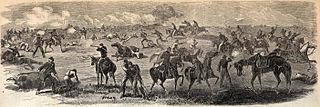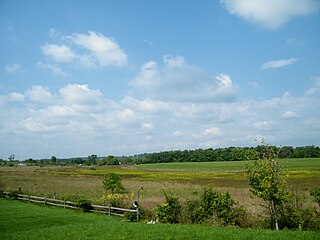
The Battle of New Market was fought on May 15, 1864, in Virginia during the Valley Campaigns of 1864 in the American Civil War. A makeshift Confederate army of 4,100 men defeated the larger Army of the Shenandoah under Major General Franz Sigel, delaying the capture of Staunton by several weeks.

The Battle of Cross Keys was fought on June 8, 1862, in Rockingham County, Virginia, as part of Confederate Army Maj. Gen. Thomas J. "Stonewall" Jackson's campaign through the Shenandoah Valley during the American Civil War. Together, the battles of Cross Keys and Port Republic the following day were the decisive victories in Jackson's Valley Campaign, forcing the Union armies to retreat and leaving Jackson free to reinforce Gen. Robert E. Lee for the Seven Days Battles outside Richmond, Virginia.

The Battle of Upperville took place in Loudoun County, Virginia on June 21, 1863 during the Gettysburg Campaign of the American Civil War.

The Third Battle of Winchester, also known as the Battle of Opequon or Battle of Opequon Creek, was an American Civil War battle fought near Winchester, Virginia, on September 19, 1864. Union Army Major General Philip Sheridan defeated Confederate Army Lieutenant General Jubal Early in one of the largest, bloodiest, and most important battles in the Shenandoah Valley. Among the 5,000 Union casualties were one general killed and three wounded. The casualty rate for the Confederates was high: about 4,000 of 15,500. Two Confederate generals were killed and four were wounded. Participants in the battle included two future presidents of the United States, two future governors of Virginia, a former vice president of the United States, and a colonel whose grandson, George S. Patton became a famous general in World War II.

William Edmondson "Grumble" Jones was a Confederate cavalry general with a reputation for being a martinet to his troopers and fractious toward superiors, but acknowledged to be a good commander. After disagreements of a personal nature with J.E.B. Stuart, Jones's brigade was set to guarding supply lines and unavailable during a crucial juncture of the Gettysburg Campaign when Lee suffered from a lack of capable reconnaissance cavalry. As the personality clash between Jones and Stuart escalated, Jones faced charges for impertinence, and was transferred to separate him from Stuart. Jones was killed leading a counter-attack in the 1864 Battle of Piedmont.

John Daniel Imboden, American lawyer, Virginia state legislator, and a Confederate army general. During the American Civil War, he commanded an irregular cavalry force. After the war, he resumed practicing law, became a writer, and was active in land development founding the town of Damascus, Virginia.

The Second Battle of Kernstown was fought on July 24, 1864, at Kernstown, Virginia, outside Winchester, Virginia, as part of the Valley Campaigns of 1864 in the American Civil War. The Confederate Army of the Valley under Lt. Gen. Jubal A. Early soundly defeated the Union Army of West Virginia under Brig. Gen. George Crook and drove it from the Shenandoah Valley back over the Potomac River into Maryland. As a result, Early was able to launch the Confederacy's last major raid into northern Union territory, attacking the Baltimore and Ohio Railroad in Maryland and West Virginia and burning Chambersburg, Pennsylvania, in retaliation for the burning of civilian houses and farms earlier in the campaign.

The Valley campaigns of 1864 began as operations initiated by Union Lieutenant General Ulysses S. Grant and resulting battles that took place in the Shenandoah Valley of Virginia during the American Civil War from May to October 1864. Some military historians divide this period into three separate campaigns. This article considers them together, as the campaigns interacted and built upon one another.
The Battle of Cool Spring, also known as Castleman's Ferry, Island Ford, Parker's Ford, and Snicker's Ferry, was a battle in the American Civil War fought July 17–18, 1864, in Clarke County, Virginia, as part of the Valley Campaigns of 1864. The battle was a Confederate victory.
The Battle of Rutherford's Farm, also known as Carter's Farm and Stephenson's Depot, was a small engagement between Confederate forces under Maj. Gen. Stephen D. Ramseur and Union forces under Brig. Gen. William W. Averell on July 20, 1864, in Frederick County, Virginia, during the American Civil War, as part of Confederate Lt. Gen. Jubal Early's Valley Campaign, resulting in a Union victory.
The Battle of Lynchburg was fought on June 17–18, 1864, two miles outside Lynchburg, Virginia, as part of the American Civil War. The Union Army of West Virginia, under Maj. Gen. David Hunter, attempted to capture the city but was repulsed by Confederate Lt. Gen. Jubal Anderson Early.
The Battle of Waynesboro was fought on March 2, 1865, at Waynesboro in Augusta County, Virginia, during the American Civil War. It was a complete victory for Brig. Gen. George Armstrong Custer and the final battle for Confederate Lt. Gen. Jubal Early, whose force was destroyed.

The Army of the Shenandoah was a field army of the Confederate States Army active during the American Civil War. It was created to defend the Shenandoah Valley of Virginia from Union Army attacks during the early months of the war. The army was transferred to reinforce the Confederate Army of the Potomac at the First Battle of Bull Run, which was the only major engagement of the war it participated in. After the battle, the army was merged into the Army of the Potomac.

The Battle of Droop Mountain occurred in Pocahontas County, West Virginia, on November 6, 1863, during the American Civil War. A Union brigade commanded by Brigadier General William W. Averell defeated a smaller Confederate force commanded by Brigadier General John Echols and Colonel William L. "Mudwall" Jackson. Confederate forces were driven from their breastworks on Droop Mountain, losing weapons and equipment. They escaped southward through Lewisburg, West Virginia; hours before a second Union force commanded by Brigadier General Alfred N. Duffié occupied the town.

The Battle of Guard Hill,Battle of Crooked Run,Battle of Cedarville, or the Battle of Front Royal took place on August 16, 1864, in Warren County, Virginia as part of Philip H. Sheridan's Shenandoah Valley Campaign of the American Civil War. Confederate forces under Richard H. Anderson were sent from Petersburg to reinforce Early. Brig. Gen. Wesley Merritt's Union cavalry division surprised the Confederate columns while they were crossing the Shenandoah River, capturing about 300. The Confederates rallied and advanced, gradually pushing back Merritt's men to Cedarville. The battle was inconclusive.
Heaton's Crossroads, also known as the Purcellville Wagon Raid, was an American Civil War skirmish that took place between Federal cavalry under Brig. Gen. Alfred N. Duffié and Confederate infantry under Maj. Gen. John C. Breckinridge on July 16, 1864, near present-day Purcellville, Virginia in Loudoun County as part of the Valley Campaigns of 1864. The action was tactically inconclusive.

Julius H. Stahel-Számwald was a Hungarian soldier who emigrated to the United States and became a Union general in the American Civil War. After the war, he served as a U.S. diplomat, a mining engineer, and a life insurance company executive. He received the Medal of Honor for gallantry in action at the Battle of Piedmont in 1864.

The 45th Virginia Infantry Regiment was an infantry regiment raised in the Commonwealth of Virginia for service in the Confederate States Army during the American Civil War. It fought mostly in the mountainous area that today encompasses the border regions of Virginia and West Virginia, and was part of Jubal Early's Army of the Valley during the Valley Campaigns of 1864.

The 14th Pennsylvania Cavalry Regiment was a cavalry regiment of the Union Army during the American Civil War. Most of its fighting happened in the last half of 1863 and full year 1864. The regiment fought mainly in West Virginia and Virginia, often as part of a brigade or division commanded by Brigadier General William W. Averell and later Brigadier General William Powell.

The 23rd Virginia Infantry Battalion, often called "Derrick's Battalion", was an infantry battalion in the Confederate Army during the American Civil War. It fought mostly in western Virginia and the Shenandoah Valley, and was usually part of a brigade commanded by John Echols or George S. Patton. By 1864, the brigade was usually part of a division commanded by Major General John C. Breckinridge or Brigadier General Gabriel C. Wharton.

















